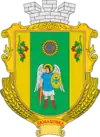Liubashivka
Liubashivka (Ukrainian: Любаші́вка, Ljubašívka, Russian: Любашёвка) is an urban-type settlement in Odessa Oblast (region), Ukraine, located of south-western Ukraine. It serves as the administrative center of Podilsk Raion (district). Population: 8,963 (2020 est.)[1]
Liubashivka
Любаші́вка | |
|---|---|
| Liubashivka | |
 Flag  Coat of arms | |
| Country | |
| Oblast | |
| Raion | Podilsk Raion |
| Established | 18th century |
| Town status | from 1957 |
| Government | |
| • Mayor | Bohdan Pavlov |
| Area | |
| • Total | 8.87 km2 (3.42 sq mi) |
| Population (2001) | |
| • Total | 11,500 |
| • Density | 1,103/km2 (2,860/sq mi) |
| Area code(s) | UA 66500 |
| Website | Liubashivka Online |
Town was founded in the 18th century. Liubashivka is primarily Ukrainophone.
Liubashivka is an important transport center and located approximately 160 kilometers from the region capital, Odessa. The town lies on a route Highway05/European route 95: Saint Petersburg — Kyiv — Odessa — Merzifon.
Through the territory of the Liubashivka pass the railroad routes. A railway from Odessa to Elisavetgrad (Kropyvnytskyi) and a railway station were built here in 1868.
Many armies passed through town in the period from 1917 to 1920, when Ukraine gained its independence from Russia for a short period of time. They represented different powers: Russian Bolsheviks, Ukrainian Central Council (Tsentralna Rada), Mahno movement and the White movement. With the end of the war, the Communist Party assumed complete control of the country. The Bolsheviks leader Joseph Stalin launched a command economy, rapid industrialization and collectivization of its agriculture. The Stalin's Ukrainian famine (1932—1933), or Holodomor was one of the largest national catastrophes in the modern history of Liubashivka.
Until World War II the town had a Jewish community. In 1940 Jewish population was 2500. In 1990 Jewish population was only 5 persons.
During World War II Liubashivka was occupied by Romanian and German forces (1941—1944). In 1991, after the collapse of Communism, the city became part of newly independent Ukraine.
There are two schools, one hospital, a railway station, and a hotel.
See also
References
- "Чисельність наявного населення України (Actual population of Ukraine)" (PDF) (in Ukrainian). State Statistics Service of Ukraine. Retrieved 30 September 2020.
| Wikimedia Commons has media related to Liubashivka. |